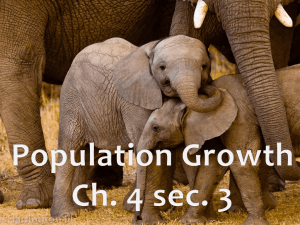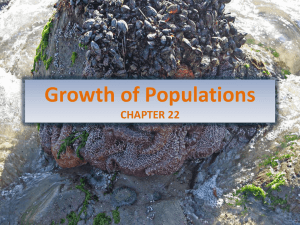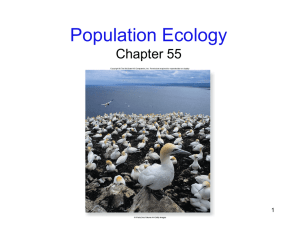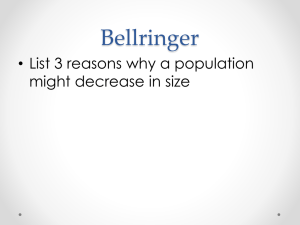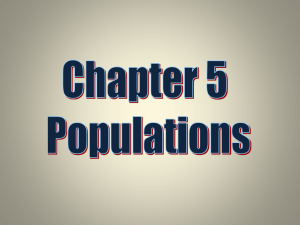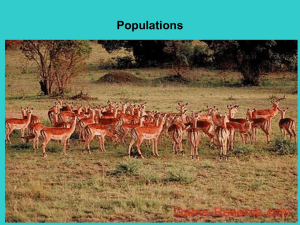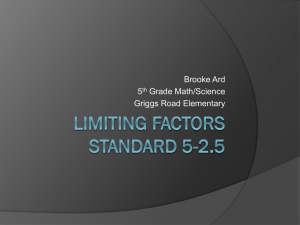Population Growth
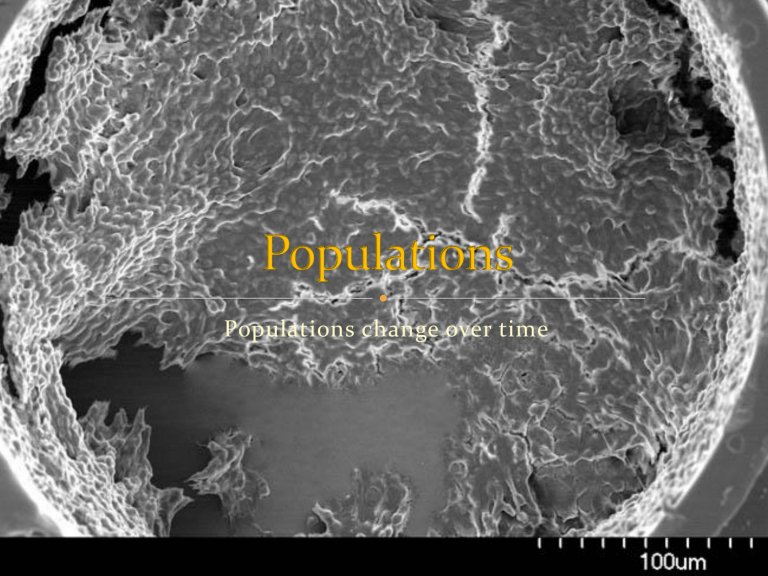
Populations change over time
• Why does the population dip at about 1400 CE?
• When does human population reach 1 billion? 2 billion?
Three important characteristics of populations:
Geographic distribution (range) – the area inhabited by a population.
Population density – the number of individuals per unit area.
Example: 30 students in one classroom.
Growth Rate – pace at which the population grows.
There is a population of bullfrogs living in Jacobson
Park. Let’s say there are 400 bullfrogs and the lake is 2 km 2 .
What is the geographic distribution of the bullfrogs?
What is the population density of bullfrogs in the lake?
Three factors can affect population size:
The number of births
The number of deaths
The number of individuals that enter or leave the population.
Immigration – the movement of individuals into an area increase in population size.
Emigration – the movement of individuals out of an area decrease in population size.
If immigration and emigration remain equal, decreased birthrate is the most important factor to slow growth rate
To continue the example with the bullfrogs…
If the bullfrog population was 400 individuals at the beginning of the year and 500 at the end of the year, what was the population’s growth?
Consider the same starting population of 400:
Suppose that 50 baby bullfrogs were eaten by great blue herons, what was the population’s growth?
Suppose that 75 adult bullfrogs were eaten by great blue herons and gigged by humans during the year, what was the population’s growth?
So, it should be clear that populations can experience negative as well as positive population growth.
Under ideal circumstances with unlimited resources, a population will grow exponentially.
Exponential growth occurs when the individuals in a group reproduce at a constant rate.
The population becomes larger and larger until it approaches an infinitely large size.
Exponential growth is characterized by a “j-shaped” curve.
Exponential Growth
How are these graphs alike/different? What do these differences indicate?
What is another major difference between the reproduction of bacteria and of elephants?
Are the lines identical? Are the rates of reproduction identical?
In nature, exponential growth does not occur for very long.
As resources become less available, the growth of a population slows or stops.
Logistic growth occurs when a population’s growth slows or stops following a period of exponential growth.
Logistic growth is characterized by an “s-shaped” curve.
The largest number of individuals of a population that given environment can support is called the carrying capacity.
When a population reaches the carrying capacity of its environment, its growth levels off. The average growth rate is zero.
When primary productivity of an ecosystem is reduced when there is an insufficient amount of a particular nutrient, what is that nutrient called?
Limiting nutrient
This is a specific example of a broader principle
Limiting factor – a factor that causes population growth to decrease.
Density-dependent factors – a limiting factor that depends on population size.
Density-dependent factors become limiting only when the population density reaches a certain level.
Can you think of any examples?
Examples include: competition, predation, parasitism, and disease.
Wolf and Moose Populations on Isle Royale
Moose Wolves
How are the increases and decreases in the moose population related to the changes in the wolf population?
What other factors could affect these populations?
In this case: wolves were affected by disease and moose by food supply.
Density-independent factors – affect all populations in similar ways regardless of population sizes.
Can you think of any examples of density-independent limiting factors on populations?
Unusual weather
Natural disasters
Seasonal cycles
Human activities – damming rivers, cutting forests, etc.
U.S. Population
Percentage of Population
Percentage of Population
1. Exponential growth rate occurs when individuals reproduce:
A. At an increasing rate
B. At a decreasing rate
C. At a constant rate
2. Population density increases due to:
A. Immigration
B. Emigration
C. Carrying capacity
3. Exponential growth slows or stops as:
A. Rate of immigration increases
B. Rate of immigration decreases
C. Resources become limited.


